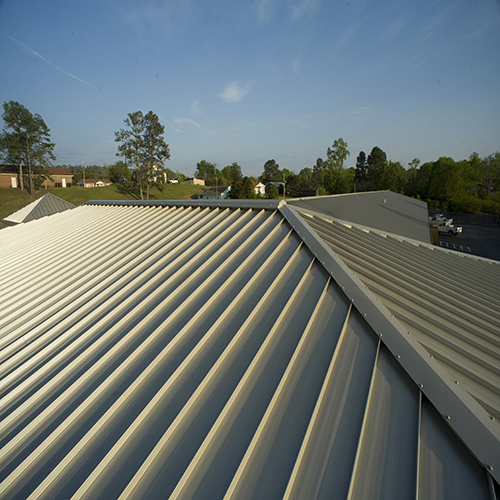- Products
- Industries
- Project Gallery
- Resource Center
- Metal Institute
- Shop
- Contact Us
August 26, 2022
by Randy Tweedt
Roofs on buildings of all types are prone to damage, wear, deterioration, or leaks. When this happens, it leaves the owner wondering whether to address the problem through repair or replace the entire roof. How to decide? There are several key considerations:
Different roofing materials require different construction methods, and range in suitability for various types of building conditions. Understanding the existing roofing type is fundamental in deciding on the best course of action.

Regardless of the roofing type, there may be a warranty in effect that requires any inspection and repair work to be performed by someone certified or approved by the roofing manufacturer. Having an independent repair on a roof that is still under warranty may render the warranty null and void. Before anyone does any work on the roof, contact the manufacturer, and confirm the applicability (or not) of a warranty. Understanding if the roof is under warranty will allow you to evaluate any other options or conditions for a repair. The advantage of a warranty is that there should be little, if any, cost to the owner to repair the roof if the work is done according to the warranty terms. Without a warranty in effect, it’s entirely up to the owner to decide whether to repair or replace the roof.
If the current owner is the original owner of the building, the roof age should be easy to determine. But what if this is a used building? The age of the roof will play directly into the cost-efficiency of a repair versus a replacement. If the roof is near the end of its service life, then a repair might not make sense if a full replacement is imminent anyway. If the roof is new, then the question of how long a repair may last is important. Will it need to be repeated before the roof is ready for replacement, and if so, at what cost?
Is it really the roofing that’s a problem? Could it be something related—such as edge flashing or seals around a roof penetration (i.e. a chimney, pipe, or rooftop equipment connection)? If the damage is in isolated areas, a simple repair or flashing replacement may be the easiest solution. If the condition is more widespread, however, then a replacement may be more logical to address the larger area(s) affected.
Buildings prone to high winds or other severe weather need a more durable roofing system than areas where the weather is less dramatic. If the building is in a high-risk area, it might be reasonable to avoid relying on repairs and instead go for a full replacement.
Sometimes, the roof covering isn’t the root of the problem. For example, Low-slope roofs often experience “ponding,” where water can sit in a slightly depressed or settled section of the roof. This can lead to deterioration and leakage over time which is not the fault of the roofing, but of the structure or insulation beneath it.
Similarly, steeper-slope roofs may be designed with a geometry or penetrations that prevent proper drainage and cause issues due to water backups. Or, perhaps ice build-up in winter is causing problems with the insulation in the roof system. Identifying the proper issue that is causing the problem will allow for selecting the best solution.
Answering the basic questions above will likely reveal which approach—repair or replace—is most appropriate. Small areas of damage in areas in low-risk locations may best be served by simple repairs. If there are many years of roof life remaining or a warranty is in effect, this is especially true. However, missing or faulty components, worn or brittle membranes, or rusting metal panels may all be indications to replace the roofing entirely. This is even more important if the roof is quite old, out of warranty, or in a high-risk area.
In our next post, we’ll look at how metal roof systems help solve a variety of problems within different budgets. In the meantime, contact your local MBCI representative to learn more about roofing warranties and roofing systems for buildings.
Check out the Metal Minutes Podcast to stay up to date on news and learn more about frequently asked questions!